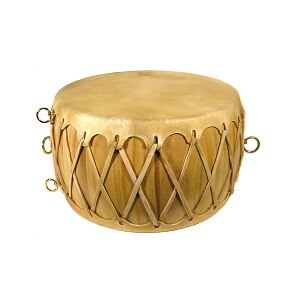Buk
 The buk is a traditional Korean drum. While the term buk is a native Korean word used as a generic term meaning "drum", it is most often used to refer to a shallow barrel-shaped drum, with a round wooden body that is covered on both ends with animal skin. Buk are categorized as hyeokbu which are instruments made with leather, and has been used for jeongak (Korean court music) and folk music.
The buk is a traditional Korean drum. While the term buk is a native Korean word used as a generic term meaning "drum", it is most often used to refer to a shallow barrel-shaped drum, with a round wooden body that is covered on both ends with animal skin. Buk are categorized as hyeokbu which are instruments made with leather, and has been used for jeongak (Korean court music) and folk music.
The version of the buk that is used in the court music are often attached with the nails on the rims, while the versions of the musical instrument that are used in the folk music are often knotted up with leather straps to form the shape of the musical instrument. Players in the court music often beat their musical instrument with the use of drum stick called bukchae on one hand or two hands together, while players of the musical instrument in the folk music generally beat their musical instrument with the stick on their right hand as beating the other side of the musical instrument with the bare left hand.
The musical instrument has been used for Korean music since the era of the three kingdom of Korea, in light with moral portraits in Anak Tomb of Goguryeo and archives of Book of Sui on the Kingdoms, Goguryeo and Baekje. In the third of Anak Tomb, two versions of this musical instrument are portrayed in the paintings called Juakdo and Haengryeold, like ipgo and damgo simultaneously. The ipgo is the version of the musical instrument that the players beat as standing up, while the damgo is the version of the musical instrument that the players of the musical instrument strike as carrying the instrument on their shoulder.